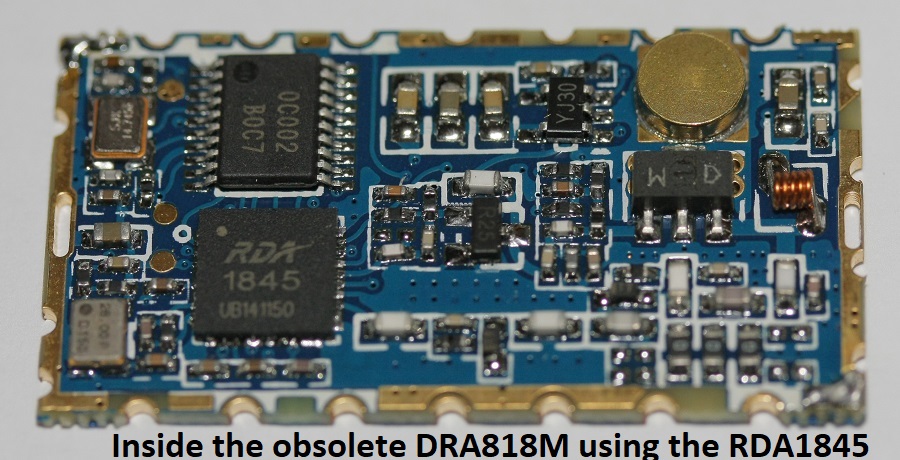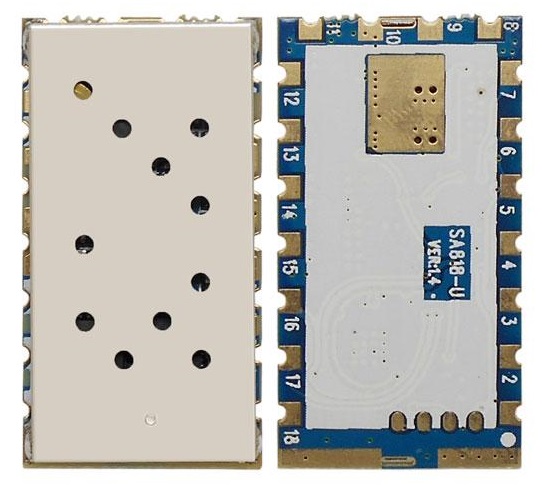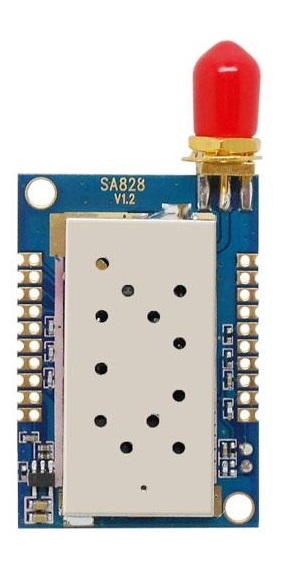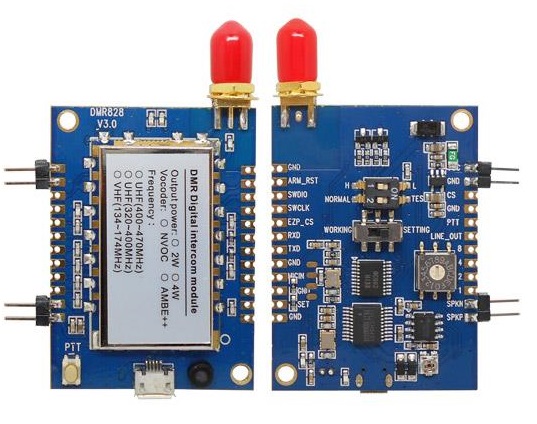Tiny
VHF/UHF Transceiver modules from China based upon the RDA1846/7 System
On a
Chip [SOC] opens the door for inexpensive remote receivers and
repeaters. The basic RDA1846 analog chip is available for under $3
each, and the RDA1847 digital/analog version is under $15 each. These
chips are second and third generation versions of the original RDA1845
chip that is widely used in many of the $25 FRS radios coming out of
China, like the Baofeng.
The main improvement of the RDA1846 is the option to control the
pre-emphasis/de-emphasis in the transmitter and receiver. Other
believed improvements were the squelch circuit and receiver
blocking. The
specifications are here, and the chips are available on Ebay
and at commercial parts houses. The 40 pin chips are very small and
would fit on the head of a pencil eraser. They are almost impossible to
use by hand, without automated pick & place robots to
assemble, they are almost useless.
A number of companies have placed the chips on about 0.75" x 1.42" carrier
boards we shall call modules, with all the necessary support
components to create a working radio. The chips can work on 3 bands,
but all of the current modules operate on a single VHF or UHF band. Most
of the modules include micro controllers [MCU], EEPROM memory, crystals
or TCXOs, so with the addition of a microphone, audio amp,
speaker, PTT button, battery and antenna, you have a working
radio that retains the specific programming. However, the transmitters have no on-board
lowpass filters, so have high harmonic output. If you build anything
with these modules, you MUST install a lowpass filter. A
comparison of some modules available in April
2018 follows:
| Make |
Dorji.com |
NiceRF.com |
NiceRF.com |
NiceRF.com |
sunrisedigit.com |
sunrisedigit.com |
NiceRF.com |
NiceRF.com |
| Model |
DRA818U |
SA818 |
SA828 |
SA858 |
SR_FRS_2WU |
FRS_DEMO_B |
DMR818 |
DMR828 |
| Form |
Module |
Module |
Board |
Board |
Module |
Board |
Module |
Board |
| Main Chip |
RDA1846 |
RDA1846 |
RDA1846 |
RDA1846 |
RDA1846 |
RDA1846 |
RDA1847 |
RDA1847 |
| Format |
Analog |
Analog |
Analog |
Analog |
Analog |
Analog |
Digital
or Analog |
Digital
or Analog |
| Avg Cost |
$9.58 |
$8 |
$16 |
$55 |
$13.50 |
$21 |
$50 |
$55 |
| Notes: |
Basic
Module |
Basic
Module |
Speaker
Amp |
Speaker
Amp & Heatsink |
Requires
External MCU |
Speaker
Amp channel sw |
Basic
Module |
Speaker
Amp |
| Stores Config |
YES
EEPROM |
YES
EEPROM |
YES
EEPROM |
YES
EEPROM |
NO
EEPROM |
YES EEPROM |
YES EEPROM |
YES EEPROM |
| # Channels |
one |
one |
16 |
16 |
one |
16 |
one |
16 |
| Tx Power |
1
Watt |
1
Watt |
1
Watt |
4
Watts |
1
Watt |
1
Watt |
1.5
Watt |
1.5
Watt |
| Tx Stability |
unstated |
1 ppm |
1 ppm |
1 ppm |
unstated |
unstated |
1 ppm |
1 ppm |
| Voltage |
3.3 - 5.0 |
3.3 - 5.0 |
3.3 - 5.0 |
3.3 - 8.5 |
3.3 - 5.0 |
3.3 - 5.0 |
3.0 - 5.0 |
3.0 - 5.0 |
| Size mm |
19 x 36 |
19 x 36 |
28 x 41 |
21 x 59 |
20 x 38 |
45 x 90 |
24 x 40 |
39 X 53 |
All of the modules are designed to be soldered onto other
larger boards, containing additional components. The products above
marked as boards, are somewhat larger than the modules and are ideal
for evaluating or building simple projects. The boards contain SMA
antenna connectors, channel switches, audio amplifiers, PTT switch,
microphone and larger solder pads for wiring. However, you
must include a low-pass filter to eliminate the transmitter harmonics.
A low-pass filter kit for VHF can be found at qrp-labs.com for under $5
or look at MiniCircuits.com for other filters like the PLP-550+ for
under $15.

The DRA818M
above is similar to the current modules. This gives you an idea what is
inside. The RDA1845 chip is 0.197" square. All modules
have a metal shield enclosing most of the assembly. This will
provide
reasonable protection for spurious radiation from the transmitter, but
it is inadequate as protection for the receiver. The use of a small tin metal box such as those available
from PaperMart.com like the tiny 656070P
or the larger 651641321P tin can with cover, to
house the module, filter and other parts. If you go to the
trouble to use a metal box, be sure to use feed-thru caps to isolate the
power, audio and other leads coming out of the box. Otherwise, unwanted signals my enter or exit the enclosure.

There are many of these modules in use by Radio Amateurs
[Hams] as
remote receivers. If you intend on using the receiver in a high RF
environment like a large city or somewhere with any TV channels nearby,
use a pre-selector or bandpass filter to limit excess off-channel
energy from overloading the receiver. Many Hams strip the
front-end
filters from older Motorola or GE radios that have several helical
resonators. These really work great and are usually several MHz broad.
It
would be advisable to do some extended temperature testing if you
plan installing these modules outdoors and if transmitting, extended
test at your desired power level. The specifications are rather sparse
and you may encounter some modules with poor temperature compensation
or unable to transmit at full power without failing. The NiceRF brand
is the only manufacturer who claims to use a KDS brand TCXO that is
specified at 1PPM. However, they do not specify an actual temperature
range for 1PPM.


Below is the digital version which includes support for many DMR
functions. Keep in mind the module was designed to be a user
terminal, otherwise a handheld or mobile. Therefore attempting to use
it for a base station or repeater may require some improvising in the digital mode.
If
the reader intends to use one of these various modules for some
commercial application, the receivers should be no problem. However,
only the DMR series modules can be Type Approved under FCC Part 90
rules, because in early 2000 the FCC decreed that only digital capable
transmitters would be approved, even if the transmitter was to be used
for analog FM only.
Two of these modules would work well as a
repeater, if they were placed in individual metal boxes. The typical
receiver standby current is only 60 ma, so you could easily operate on
solar. The transmitter should be powered through a timer so if no
activity occurs for maybe 5 minutes, the transmitter is powered down
completely to save battery. The first key-up of the repeater might take
another 1/3 second, or less. If the antennas were far apart, or
the frequencies were far apart, then you would not require a duplexer.
If you wanted to separate the antennas, instead of running coax, simply
place the modules with the antennas and connect with a pair of
wires to carry the audio and power between them. Simply reverse
polarity to transmit. Vertical separation of antennas always
provides vastly greater isolation than horizontal separation. But
at 1 watt, it may not be noticeable.

Last revision April 25, 2018 by Fred Daniel




